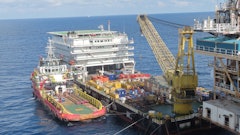
Healthy U.S. import volumes in the first half of 2025 have not translated into stronger demand for industrial commercial real estate in many port-proximate markets, according to Cushman & Wakefield’s U.S. Midyear Ports Update.
Excess capacity among industrial occupiers and a shift toward moving goods directly to inland hubs like Chicago and Dallas are keeping inventory levels and leasing activity subdued near several major ports.
“Import totals remain strong, but the dynamics of how goods move through the supply chain have shifted,” says Jason Price, senior director, Americas head of logistics and industrial research. “With more cargo going directly inland and some tenants still working through excess space, port-adjacent industrial markets are currently seeing less of the benefit from elevated trade activity.”
Key takeaways:
· While cargo volumes at the nation’s 10 busiest ports rose 3.5% year-over-year in Q1, absorption in half of the top port-proximate markets has been negative, and vacancy rates have inched higher.
· Historically, industrial markets near key U.S. ports have recorded strong net absorption annually, accounting for 21% of the nationwide absorption from 2019 through 2024. However, through the first half of this year, that number has dwindled to 2.2%, despite accounting for 24% of total national inventory. Los Angeles, the Inland Empire, Oakland, and New Jersey have all seen asking rents decline as market fundamentals soften.
- Inland Empire vacancy reaches 2011 levels, with 5.4 million square feet delivered in H1 2025 and supply still outpacing demand.
- Construction slowdown may bring balance: the national pipeline is down 41% since late 2023, and the port-proximate pipeline is down 47%.
- Long-term outlook remains positive, with forecasted five-year rent growth of 12% to 22% in key markets such as Savannah, Miami, New Jersey, and Houston.
- While short-term headwinds are expected to persist, driven by evolving logistics strategies, inflationary pressures, and shifting trade flows, the report projects that port-proximate industrial markets will regain momentum from 2027 onward, with strategic locations near major maritime gateways remaining essential to national distribution networks.
“Although some short-term choppiness is anticipated, port-proximate industrial markets are poised to see healthy growth long-term due to both the strategic need for facilities around major maritime ports and key population centers. Double-digit rent growth over the next five years is forecasted for eight of the 13 industrial markets associated with the top 10 U.S. ports,” says Price.




















